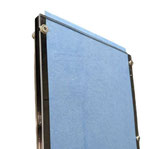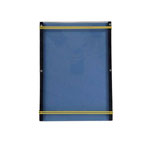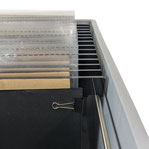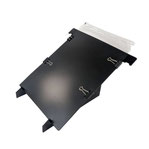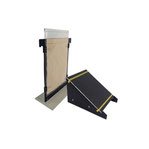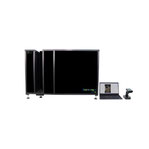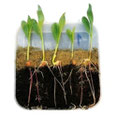Soil-free Systems for Root Phenotyping, Molecular Analysis & Bioassays
Root phenoboxes and growth pouch and germination pouch systems are used for soil-free, high throughput root phenotyping, molecular analysis & bioassays. Vienna Scientific offers growth pouches, seed germination pouches and root phenobox systems for root monitoring / root phenotyping and seedling experiments (including inoculation with rhizobia), and bioassays on seedlings in vivo under controlled, soil-free conditions using creped seed growth / seed germination paper.
Growth Pouch & Phenobox Systems
Root Phenobox. System for advanced soilless root phenotyping with growth resistance - a spongy middle layer gently presses the germination paper against the transparent front panels.
Growth Pouches "Type 1". Classical seed germination pouch system with positioning panel and germination paper in a foil sleeve. Suitable for PhenoRack Systems with rewetting from bottom reservoir or water in plastic sleeves. Custom sizes and sets available - please submit the GP Type 1 Configuration form (pdf) for custom pouches. Standard pouch positioning panels available online.
Rigid Growth Pouches "Type 2". "Hybrid system" between Rhizobox and classic growth pouch with a rigid transparent front. Suitable for larger seeds and large diameter plant roots (corn etc.). Custom sizes and set available.
Accessories for Root Phenotyping Pouches
PhenoRack. Storage solution for growth pouches / seed germination pouches in high throughput root phenotyping systems, and benchtop plant screening systems in the lab. Configure by submitting the GP Type 1 Configuration form (pdf) or get preconfigured PhenoRack sets online.
Shading Panels for Growth Pouches & Root Phenoboxes. Effectively prevents light from reaching roots growing on germination paper phenotyping platforms. Made to fit all VSI germination pouches and to retrofit established root phenotyping systems. Purchase standard growth pouch light shield sizes online.
Set-up Stand (90°) & Manipulation Stand (30°) for pouches. 90° stands allow growth pouches to be established / manipulated when not placed in racks / PhenoRacks. 30° pouch manipulation stands allow for convenient root sampling / plant manipulation and are a great way to create educational displays on root phenotypes. Standard growth pouch stands are available online.
Growth/Germination Pouch Imaging. The LK-1250 imaging system was originally designed for semi-automatic digital imaging of rhizoboxes. However, adapters can be added to the imager to enable high throughput and reliable imaging of germination paper-based root screening systems. Contact us for details.
Growth Pouch Phenotyping Tools - Online

Root Phenoboxes, Root Growth Pouches and Stands are available in 3-5 mm acrylic (transparent and black) with a recycling rate of 70%. Root phenotyping products are produced from newly extruded PMMA unless specifically ordered by customers. Contact us if a more sustainably produced acrylic fits your root phenotyping needs. Go Green!
Germination Paper-based Plant Screening - A Window to Root Development
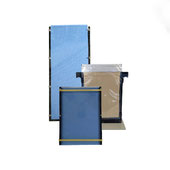
Growing paper-based root phenotyping systems, aka seed germination pouches, are suitable for screening root system architectures (RSA) of large numbers of seedlings in a rapid and cost-effective manner - allowing their integration into high-throughput (HT) root phenotyping platforms. Read more on the application of growth pouches for root phenotyping. In addition, the soil-free conditions allow the establishment of standardized protocols for plant bioassays and easier, "clean" sample recovery for molecular analysis. Seed germination pouch systems using plants grown vertically on germination paper / blotter paper have thus been successfully used in seedling root screens for many years & species - using growth pouch set-ups of many different configurations. For efficient placement and handling of root pouches, pouch PhenoRacks and Manipulation Stands are key. Alternatively, Root Phenoboxes provide mechanical resistance to root systems developing on the germination paper.
Vienna Scientific offers standard sets and custom-made growth pouch and root phenobox systems to meet your root research and bioassay objectives. Contact us to discuss cost-effective germination pouch systems!
Seed Germination Paper properties
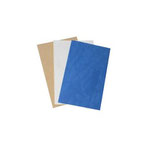
- In short, seed germination paper for 2D germination pouch phenotyping should have a creped surface. The germination paper should therefore have an open, porous structure and be inert, i.e. free from impurities or substances that may affect seed germination and root growth. Papers should have a high and uniform water retention capacity, remain mechanically stable under wet conditions for a prolonged period of time, and not allow ingrowth of roots or root hairs. In addition, the germination paper should also be free of fungi or bacteria which might interfer with seedling growth and evaluation of results. Show more
-
Seeds may be surface sterized to reduce the risk of microbial contamination. While a range of companies offer creped germination papers, a classical provider of such papers for root observation tasks is the Anchor Paper Company, MN, USA. Anchor offers regular / heavy weight germination papers in the sizes 10 x 15 inch (25.4 x 38.1 cm), 10 x 20 inch (25.4 x 50.8 cm), 12 x 18 inch (30.48 x 45.72 cm) and 12 x 24 inch (30.48 x 60.96 cm) sizes from stock. However, Anchor also offers free custom cutting, giving you the freedom to design your own Growth Pouches / Root Phenoboxes. Steel blue, white and tan germination blotters are available from Anchor in 19 x 24 inch (48.26 cm x 60.96 cm) sheets. Commercial germination pouches hold tan blotter paper inside (sterile) plastic bags and a special fold to securely place seeds.
For experimental root phenotyping systems in soil, see the Rhizobox systems, or for waterlogged conditions, the hydroponic RootBoxes. See the Rhizobox Online Shop for standard sizes.
See field- or rhizotron-installed root observation windows and minirhizotron cameras for large scale root and rhizosphere observation systems in (near) target environments.
To create a sterile and particle-free environment during growth pouch preparation, consider using Biobase laminar flow cabinets - minimising the risk of contamination.

